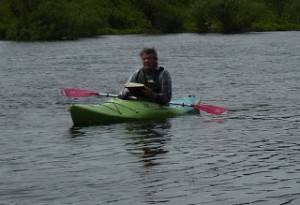Some good folk may well manage to get out blogs while on a camel trek to Samarkand, but alas, when you are carrying all your art gear, a full china tea set and a spare rucsack full of Danish pastries it’s a bit much to include blogging devices as well. Hence the lack of blog posts – I’ve been out at the ‘sharp end’ for a few weeks, though staying at the superb Sunstar hotel in Zermatt was hardly roughing it. The staff were brilliant, providing that marvellous Swiss hospitality, though as I couldn’t get them to provide an after-dinner yodelling session the entertainment for the painting group with us was reduced to the notorious Bellamy’s Bedtime Stories.
 Unsurprisingly, this post therefore covers complicated Alpine scenery, which certainly challenged the painters. In this watercolour sketch of the Matterhorn from the Theodulgletschersee I chose this medium because I wanted to record the colours, many of which were quite extraordinary, especially in the rock band directly beyond the lake. Some of these were violent reds, looking as though they’d just erupted from the earth’s interior – a geologist’s heaven. I’ve also brought out some of the varied colour on the mountain itself, and it pays to look for these nuances in colour when the subject is before you.
Unsurprisingly, this post therefore covers complicated Alpine scenery, which certainly challenged the painters. In this watercolour sketch of the Matterhorn from the Theodulgletschersee I chose this medium because I wanted to record the colours, many of which were quite extraordinary, especially in the rock band directly beyond the lake. Some of these were violent reds, looking as though they’d just erupted from the earth’s interior – a geologist’s heaven. I’ve also brought out some of the varied colour on the mountain itself, and it pays to look for these nuances in colour when the subject is before you.
The sketch looks complicated, is a little over-worked, but I was more concerned with getting plenty of detail for the finished painting which I will do later in the studio. Even then it is considerably simplified. By all means overload, overwork and over-write on your sketches, as they are a working document, and the main simplification should appear in the final painting. As the painting is usually larger than the sketch you can see why we need more detail than looks right on many sketches. There wasn’t a cloud in the sky but I added one to break up the harsh lines of the mountain to show students a useful device. We had blazing hot sunshine every day so where there was no shade sketching proved quite a challenge when presented with all that glaring white paper, and the consequent difficulties in assessing tonal values.
This autumn I have another of my watercolour seminars in Great Bookham near Guildford, which coincides with my next exhibition in the Lincoln Joyce gallery just across the road. The Old Barn Hall in Great Bookham is a fine venue and my theme this year is painting animals and birds in the landscape.
Over the years wildlife has given me such great pleasure, sometimes great hilarity and occasionally a few scrapes. The first session is a painting demonstration, and after a break for refreshments it will be followed by an illustrated talk which will include British landscapes with farm animals, birds and wildlife, plus many wildlife scenes from the Arctic, Africa and other places. This will cover animals in some detail and those that are hardly visible or in the distance, and how to include them in your composition. Birds will tend to be less detailed by comparison. Naturally, there will be a variety of scenery, skies and atmosphere. For more details please check out my website Tickets can be obtained from the website or from Lincoln Joyce Fine Art (Tel 01372 458481) Both sessions will be packed with techniques and wild experiences, so do come along and join in the fun.





